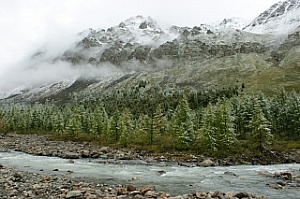Denmark recently hosted an annual meeting of INTERACT, the international Arctic change monitoring program. The program brings together more than 80 Arctic and high altitude research stations in Northern Europe, the USA, Canada, Greenland, Scotland, and Russia, including three TSU bases open to all project participants. In 2020, scientific working groups will conduct a wide range of studies, from clarifying the characteristics of permafrost and fire melting in boreal forests to studying the effects of heatwaves on DNA and the endurance of Arctic bumblebees.
- The results of the INTERACT II project, which is the largest to study climate change in the Arctic and the northern territories, were summed up at the annual meeting of the consortium participants,- says Olga Shaduiko, director of the TSU Center for International Collaboration. - The research confirms the trend towards climate warming, and therefore research in the Arctic and the North is becoming increasingly important. It is here that environmental transformation is most noticeable, so the demand for TSU research stations, which are part of the Interact transnational access system, is growing.
Applicants for research for 2020 were identified by expert selection. Researchers from France, Britain, Germany, Poland, Belgium, and other countries will work at the scientific bases of Tomsk State University. Among the teams, there are those who, having received good results, will return to the TSU bases for the second time. For example, scientists from the University of Adam Mickiewicz (Poland) previously conducted work in the Khanty-Mansi Autonomous Okrug at the stations Khanymey and Mukhrino (included in the TSU SecNet network). They investigated peat deposits to reconstruct the picture of hydroclimatic changes in permafrost and boreal peatlands associated with global warming over the past 1,000 years.
In 2020, scientists from Poland plan to view peatlands as an archive of past fires. Using the paleoecological method, researchers will analyze the reaction of peatlands to climate change in the Holocene (the recent millennia).
- In the near future, an increase in average annual temperature and a decrease in precipitation is predicted, while fire activity and droughts will intensify in many parts of the world in response to global climate warming,- scientists from the Adam Mickiewicz University noted in the project application. - Conducting research in the Khanty-Mansi Autonomous Okrug will help to identify and understand the response of peat ecosystems to hydroclimatic changes. Along with this, it is necessary to be able to predict these processes. Peatlands are of particular importance for the planet because they are powerful sinks of carbon, one of the main components of greenhouse gases.
Scientists from Belgium who study the northern species of bumblebees as an indicator of climate change will also work at the TSU station. In 2017, at Khanymey, they received interesting data on how heat and cold stress affect pollinating insects. In 2020, they intend to conduct similar studies at the Aktru station.
In addition, several other research groups received a positive opinion from the experts and will conduct their research with the support of TSU. Scientists from the Czech Republic expect to obtain new data on the Tardigarda, microscopic invertebrates, which are also called water bears, on their expedition to Aktru. These animals can live in severe conditions, including on glaciers, and be in a state of suspended animation for up to several hundred years.

